Computer Networking > EXAM > Business Data Networks and Security, 11e (Panko) > Chapter 1 Core Network Concepts and Terminology>2 (All)
Business Data Networks and Security, 11e (Panko) > Chapter 1 Core Network Concepts and Terminology>2019>Scored A.
Document Content and Description Below
1) Flooding a host with traffic so that it cannot serve its legitimate users is a ________ attack. A) hacking B) virus C) malware D) DoS Difficulty: Basic Question: 1a Objective: Discuss how the Inter... net is changing and the security challenges these changes are creating. AACSB: Applying Information Technology 2) The KrebsOnS attack ________. A) was a denial of service attack. B) used IoT devices to attack the site C) both A and B D) neither A nor B Difficulty: Basic Question: 1b Objective: Discuss how the Internet is changing and the security challenges these changes are creating. AACSB: Applying Information Technology, Analytical Thinking 3) Internet communication that does not involve a human is referred to with the term ________. A) World Wide Web B) impersonal C) anonymous D) IoT Difficulty: Difficult Question: 1c Objective: Discuss how the Internet is changing and the security challenges these changes are creating. AACSB: Applying Information Technology, Analytical Thinking 4) If a host cannot reach a DNS server, it ________. A) cannot have a host name B) will have to rely on host names C) will need to use a DHCP server D) is unlikely to be able to communicate with most server hosts Difficulty: Difficult Question: 1d Objective: Discuss how the Internet is changing and the security challenges these changes are creating. AACSB: Applying Information Technology, Analytical Thinking 5) The Mirai bots in the KrebsOnS attack were ________. A) client hosts B) server hosts C) IoT devices D) all of the above Difficulty: Basic Question: 1e Objective: Discuss how the Internet is changing and the security challenges these changes are creating. AACSB: Applying Information Technology 6) ISPs ________. A) carry traffic in the Internet B) connect users to the Internet C) both A and B D) neither A nor B Difficulty: Basic Question: 3a Objective: Discuss how the Internet is changing and the security challenges these changes are creating. AACSB: Applying Information Technology, Analytical Thinking 7) A packet sent from one host to another over the Internet will ALWAYS pass through ________. A) a single ISP B) more than 2 ISPs C) exactly 2 ISPs D) none of the above Difficulty: Difficult Question: 3c Objective: Discuss how the Internet is changing and the security challenges these changes are creating. AACSB: Applying Information Technology, Analytical Thinking, Application of Knowledge 8) We call any device connected to the Internet a(n) ________. A) IP B) client C) router D) host Difficulty: Basic Question: 4a Objective: Discuss how the Internet is changing and the security challenges these changes are creating. AACSB: Applying Information Technology 9) Which of the following is a host when it's on a network? A) a client PC B) a server C) a mobile phone D) all of the above Difficulty: Basic Question: 4b Objective: Discuss how the Internet is changing and the security challenges these changes are creating. AACSB: Applying Information Technology 10) Which of the following is constantly leading to new applications? A) increasing speed B) increasing reliability C) increasing availability wherever you are D) all of the above Difficulty: Basic Question: 5a Objective: Discuss how the Internet is changing and the security challenges these changes are creating. AACSB: Applying Information Technology, Analytical Thinking 11) Who owns the Internet? A) The U.S. Government B) The United Nations C) The IETF D) No one Difficulty: Basic Question: 6a Objective: Discuss how the Internet is changing and the security challenges these changes are creating. AACSB: Applying Information Technology 12) Who is in charge of the Internet? A) the U.S. Government B) the United Nations C) the IETF D) No one Difficulty: Basic Question: 6b Objective: Discuss how the Internet is changing and the security challenges these changes are creating. AACSB: Applying Information Technology 13) The IETF primarily ________. A) manages the Internet B) creates Internet standards C) coordinates the work of ISPs D) all of the above Difficulty: Difficult Question: 6c Objective: Discuss how the Internet is changing and the security challenges these changes are creating. AACSB: Applying Information Technology, Analytical Thinking 14) From a security perspective, the Internet's ability to give access to nearly everyone is a ________. A) good thing B) bad thing C) both A and B D) neither A nor B Difficulty: Difficult Question: 7b Objective: Discuss how the Internet is changing and the security challenges these changes are creating. AACSB: Applying Information Technology, Analytical Thinking 15) In the name Internet, "inter" means ________. A) between B) interior C) international D) interplanetary Difficulty: Basic Question: 8a Objective: Discuss how the Internet is changing and the security challenges these changes are creating. AACSB: Applying Information Technology 16) Depicting the Internet as a cloud symbolizes ________. A) the Internet is amorphous B) the Internet today is too complex to be understandable by humans C) the Internet is too complex for anyone to depict D) users do not have to know how the Internet operates Difficulty: Basic Question: 9a Objective: Explain basic concepts and terminology for the hosts (devices) that connect to the Internet. AACSB: Applying Information Technology, Analytical Thinking 17) When you use your tablet to access the internet, the tablet is a ________. A) client host B) server host C) both A and B D) neither A nor B Difficulty: Basic Question: 10a Objective: Explain basic concepts and terminology for the hosts (devices) that connect to the Internet. AACSB: Applying Information Technology, Application of Knowledge 18) Most servers are ________. A) mainframes B) Windows PCs C) rack servers D) routers Difficulty: Basic Question: 10b Objective: Explain basic concepts and terminology for the hosts (devices) that connect to the Internet. AACSB: Applying Information Technology 19) The client program is usually a browser. Difficulty: Basic Question: 11b Objective: Explain basic concepts and terminology for the hosts (devices) that connect to the Internet. AACSB: Applying Information Technology, Analytical Thinking, Application of Knowledge 20) The server program is always a webserver program. Difficulty: Basic Question: 11c Objective: Explain basic concepts and terminology for the hosts (devices) that connect to the Internet. AACSB: Applying Information Technology, Analytical Thinking, Application of Knowledge 21) The network stack implements the ________ layer process. A) application B) transport C) physical D) data link Difficulty: Difficult Question: 12a Objective: Explain basic concepts and terminology for the hosts (devices) that connect to the Internet. AACSB: Applying Information Technology, Application of Knowledge 22) The transport process always fragments the application message. Difficulty: Difficult Question: 12c Objective: Explain basic concepts and terminology for the hosts (devices) that connect to the Internet. AACSB: Applying Information Technology, Application of Knowledge 23) What process adds a header in front of an application message or fragment? A) application B) transport C) internet D) data link Difficulty: Basic Question: 12d Objective: Explain basic concepts and terminology for the hosts (devices) that connect to the Internet. AACSB: Applying Information Technology, Analytical Thinking, Application of Knowledge 24) A TCP message is called a ________. A) datagram B) packet C) frame D) none of the above Difficulty: Basic Question: 12e Objective: Explain basic concepts and terminology for the hosts (devices) that connect to the Internet. AACSB: Applying Information Technology 25) What process adds a header in front of a TCP segment? A) Application B) Transport C) Internet D) Data Link Difficulty: Basic Question: 12f Objective: Explain basic concepts and terminology for the hosts (devices) that connect to the Internet. AACSB: Applying Information Technology, Analytical Thinking, Application of Knowledge 26) An IP packet may include a(n) ________. A) application message or fragment B) TCP segment or UDP datagram C) both A and B D) neither A nor B Difficulty: Difficult Question: 13 Objective: Explain basic concepts and terminology for the hosts (devices) that connect to the Internet. AACSB: Applying Information Technology, Application of Knowledge 27) When a frame arrives, the data link process on the destination host ________. A) adds a header B) removes a header C) both A and B D) neither A nor B Difficulty: Basic Question: 14a Objective: Explain basic concepts and terminology for the hosts (devices) that connect to the Internet. AACSB: Applying Information Technology, Application of Knowledge 28) The transport layer on the destination host ________. A) reassembles the application message if it has been fragmented B) removes the transport header C) both A and B D) neither A nor B Difficulty: Difficult Question: 14b Objective: Explain basic concepts and terminology for the hosts (devices) that connect to the Internet. AACSB: Applying Information Technology, Application of Knowledge 29) IPv4 addresses are ________ bits long. A) 32 B) 64 C) 128 D) none of the above Difficulty: Basic Question: 15a Objective: Explain basic concepts and terminology for the Internet itself. AACSB: Applying Information Technology 30) ________ addresses are 32 bits long. A) IPv4 B) IPv6 C) EUI-48 D) none of the above Difficulty: Basic Question: 15a Objective: Explain basic concepts and terminology for the Internet itself. AACSB: Applying Information Technology 31) Which is NOT in an IP packet? A) Internet header B) Transport header C) Data link header D) All of the above are part of the IP packet. Difficulty: Difficult Question: 16a Objective: Explain basic concepts and terminology for the Internet itself. AACSB: Applying Information Technology, Analytical Thinking 32) To deliver IPv4 packets, routers look at the ________ addresses. A) dotted decimal notation B) EUI-48 C) IPv4 D) all of the above Difficulty: Basic Question: 16c Objective: Explain basic concepts and terminology for the Internet itself. AACSB: Applying Information Technology, Application of Knowledge 33) Routing is based on a(n) ________. A) IP address B) single-network address C) either A or B D) neither A nor B Difficulty: Basic Question: 17a Objective: Explain basic concepts and terminology for the Internet itself. AACSB: Applying Information Technology, Application of Knowledge 34) Router forwarding is called ________. A) routing B) switching C) forwarding D) none of the above Difficulty: Difficult Question: 17b Objective: Explain basic concepts and terminology for the Internet itself. AACSB: Applying Information Technology 35) paths across a single network are called ________. A) routes B) data links C) physical links D) none of the above Difficulty: Basic Question: 18a Objective: Explain basic concepts and terminology for the Internet itself. AACSB: Applying Information Technology 36) When a source host sends a packet to a destination host, there will probably be ________ along the way. A) more routes B) more data links C) about the same number of routes and data links D) all of the above Difficulty: Difficult Question: 18d Objective: Explain basic concepts and terminology for the Internet itself. AACSB: Applying Information Technology, Analytical Thinking, Application of Knowledge 37) If there are 10 routers between the source and destination hosts, how many transport processes will be involved on all devices? A) 1 B) 2 C) 10 D) 12 Difficulty: Difficult Question: 19a Objective: Explain basic concepts and terminology for the Internet itself. AACSB: Applying Information Technology, Analytical Thinking, Application of Knowledge 38) If there are 10 routers between the source and destination hosts, how may internet processes will be involved on all devices? A) 1 B) 2 C) 10 D) 12 Difficulty: Difficult Question: 19a Objective: Explain basic concepts and terminology for the Internet itself. AACSB: Applying Information Technology, Analytical Thinking, Application of Knowledge 39) Which of the following is an Internet supervisory protocol? A) DNS B) IP C) both A and B D) neither A nor B Difficulty: Difficult Question: 20 Objective: Explain basic concepts and terminology for the Internet itself. AACSB: Applying Information Technology, Analytical Thinking, Application of Knowledge 40) On the Internet, a ________ host usually gets a dynamic IP address. A) client B) server C) both A and B D) neither A nor B Difficulty: Basic Question: 21a Objective: Explain basic concepts and terminology for the Internet itself. AACSB: Applying Information Technology 41) On the Internet, a ________ host usually gets a static IP address. A) client B) server C) both A and B D) neither A nor B Difficulty: Basic Question: 21b Objective: Explain basic concepts and terminology for the Internet itself. AACSB: Applying Information Technology 42) A host with a(n) ________ IP address is easier to find than a host with a ________ IP address. A) dynamic, static B) static, dynamic C) undetermined, static D) undetermined, dynamic Difficulty: Basic Question: 21c Objective: Explain basic concepts and terminology for the Internet itself. AACSB: Applying Information Technology, Analytical Thinking, Application of Knowledge 43) A DHCP server to assigns the client host the same IP address each time. Difficulty: Basic Question: 21d Objective: Explain basic concepts and terminology for the Internet itself. AACSB: Applying Information Technology 44) When Host A wishes to communicate with Host B, a DNS server provides the IP address of ________. A) Host A B) the DNS server C) Host B D) none of the above Difficulty: Basic Question: 22b Objective: Explain basic concepts and terminology for the Internet itself. AACSB: Applying Information Technology, Analytical Thinking, Application of Knowledge 45) When Host A wishes to talk with Host B, the DHCP server provides the IP address of ________. A) Host A B) DNS server C) Host B D) all of the above Difficulty: Difficult Question: 22b Objective: Explain basic concepts and terminology for the Internet itself. AACSB: Applying Information Technology, Analytical Thinking, Application of Knowledge 46) The originating host needs to contact the DNS server each time it sends a packet to the target host. Difficulty: Basic Question: 22c Objective: Explain basic concepts and terminology for the Internet itself. AACSB: Applying Information Technology 47) In a single switched network, a ________ connects consecutive switches. A) physical link B) data link C) route D) none of the above. Difficulty: Basic Question: 23a Objective: Explain basic concepts and terminology for single networks and their role on the Internet. AACSB: Applying Information Technology, Application of Knowledge 48) In a point-to-point single network, how many physical links will there be when a packet is transmitted? A) 0 B) 1 C) 2 D) We cannot say with the information provided. Difficulty: Basic Question: 23b Objective: Explain basic concepts and terminology for single networks and their role on the Internet. AACSB: Applying Information Technology, Analytical Thinking, Application of Knowledge 49) When a packet is transmitted, there is a single data link in each ________. A) point-to-point single network B) switched network C) both A and B D) neither A nor B Difficulty: Basic Question: 23c Objective: Explain basic concepts and terminology for single networks and their role on the Internet. AACSB: Applying Information Technology, Analytical Thinking, Application of Knowledge 50) In a point-to-point single network, there is always the same number of physical and data links. Difficulty: Difficult Question: 23c Objective: Explain basic concepts and terminology for single networks and their role on the Internet. AACSB: Applying Information Technology, Analytical Thinking, Application of Knowledge 51) Which of the following is true? A) Frames are carried inside packets. B) Packets are carried inside frames. C) both A and B D) neither A nor B Difficulty: Basic Question: 25a Objective: Explain basic concepts and terminology for single networks and their role on the Internet. AACSB: Applying Information Technology 52) A host sends a packet to another host containing seven single networks along the way. How many other hosts will there be along the route when Host A transmits? A) 1 B) 2 C) 7 D) 9 Difficulty: Difficult Question: 25b Objective: Explain basic concepts and terminology for single networks and their role on the Internet. AACSB: Applying Information Technology, Analytical Thinking, Application of Knowledge 53) A host sends a packet to another host containing six single networks along the way. How many data links are used for this transmission? A) 1 B) 6 C) 7 D) 8 Difficulty: Difficult Question: 25c Objective: Explain basic concepts and terminology for single networks and their role on the Internet. AACSB: Applying Information Technology, Analytical Thinking, Application of Knowledge 54) A host sends a packet to another host containing six single networks along the way. How many routes are included in this transmission? A) 1 B) 6 C) 7 D) 8 Difficulty: Basic Question: 25d Objective: Explain basic concepts and terminology for single networks and their role on the Internet. AACSB: Applying Information Technology, Application of Knowledge 55) A host sends a packet to another host with six single networks along the way. How many frames are involved? A) 1 B) 6 C) 7 D) 8 Difficulty: Basic Question: 25e Objective: Explain basic concepts and terminology for single networks and their role on the Internet. AACSB: Applying Information Technology, Application of Knowledge 56) A host sends a packet to another host with six single networks along the way. How many packets are involved in this transmission? A) 1 B) 6 C) 7 D) 8 Difficulty: Basic Question: 25d Objective: Explain basic concepts and terminology for single networks and their role on the Internet. AACSB: Applying Information Technology, Application of Knowledge 57) In a single switched network with seven switches between a source and destination host, the source host addresses the frame ________. A) to the first switch B) to the destination host C) to the first router D) to the final switch Difficulty: Difficult Question: 25g Objective: Explain basic concepts and terminology for single networks and their role on the Internet. AACSB: Applying Information Technology, Analytical Thinking, Application of Knowledge 58) The final router in a route sends the packet being routed in a frame addressed to the ________. A) next-hop router B) destination host C) local router D) default router Difficulty: Difficult Question: 25h Objective: Explain basic concepts and terminology for single networks and their role on the Internet. AACSB: Applying Information Technology, Analytical Thinking, Application of Knowledge 59) All data link addresses are EUI-48 addresses. Difficulty: Basic Question: 26a Objective: Explain basic concepts and terminology for single networks and their role on the Internet. AACSB: Applying Information Technology 60) Source and destination IP addresses are found in the ________ header. A) IP B) Frame C) TCP D) all of the above. Difficulty: Basic Question: 26b Objective: Explain basic concepts and terminology for single networks and their role on the Internet. AACSB: Applying Information Technology, Application of Knowledge 61) Source and destination EUI-48 addresses are found in ________ headers. A) IP B) frame C) TCP D) UDP Difficulty: Basic Question: 26c Objective: Explain basic concepts and terminology for single networks and their role on the Internet. AACSB: Applying Information Technology, Application of Knowledge 62) Ethernet uses ________ addresses. A) IPv4 B) IPv6 C) MAC D) EUI-48 Difficulty: Basic Question: 26d Objective: Explain basic concepts and terminology for single networks and their role on the Internet. AACSB: Applying Information Technology 63) Wi-Fi uses ________ addresses. A) IPv4 B) IPv6 C) MAC D) EUI-48 Difficulty: Basic Question: 26e Objective: Explain basic concepts and terminology for single networks and their role on the Internet. AACSB: Applying Information Technology 64) Which of the following uses EUI-48 addresses? A) Ethernet B) Wi-Fi C) both A and B D) neither A nor B Difficulty: Basic Question: 26e Objective: Explain basic concepts and terminology for single networks and their role on the Internet. AACSB: Applying Information Technology, Analytical Thinking, Application of Knowledge 65) Hosts on the Internet have ________ addresses. A) IP B) data link C) both A and B D) neither A nor B Difficulty: Difficult Question: 26f Objective: Explain basic concepts and terminology for single networks and their role on the Internet. AACSB: Applying Information Technology, Analytical Thinking, Application of Knowledge 66) ________ have access points. A) Home access routers B) Internet core routers C) both A and B D) neither A nor B Difficulty: Basic Question: 27a Objective: Explain the distinctions between Internet routers and personal access routers; explain the differences between personal access routers and wireless access points. AACSB: Applying Information Technology, Application of Knowledge 67) ________ have DHCP servers. A) Home access routers B) Internet core routers C) both A and B D) neither A nor B Difficulty: Basic Question: 27a Objective: Explain the distinctions between Internet routers and personal access routers; explain the differences between personal access routers and wireless access points. AACSB: Applying Information Technology, Application of Knowledge 68) Which of the following has better access point capabilities? A) Home access routers B) Corporate access points C) Both have about the same access point capabilities. Difficulty: Basic Question: 27c Objective: Explain the distinctions between Internet routers and personal access routers; explain the differences between personal access routers and wireless access points. AACSB: Applying Information Technology, Application of Knowledge [Show More]
Last updated: 1 year ago
Preview 1 out of 19 pages
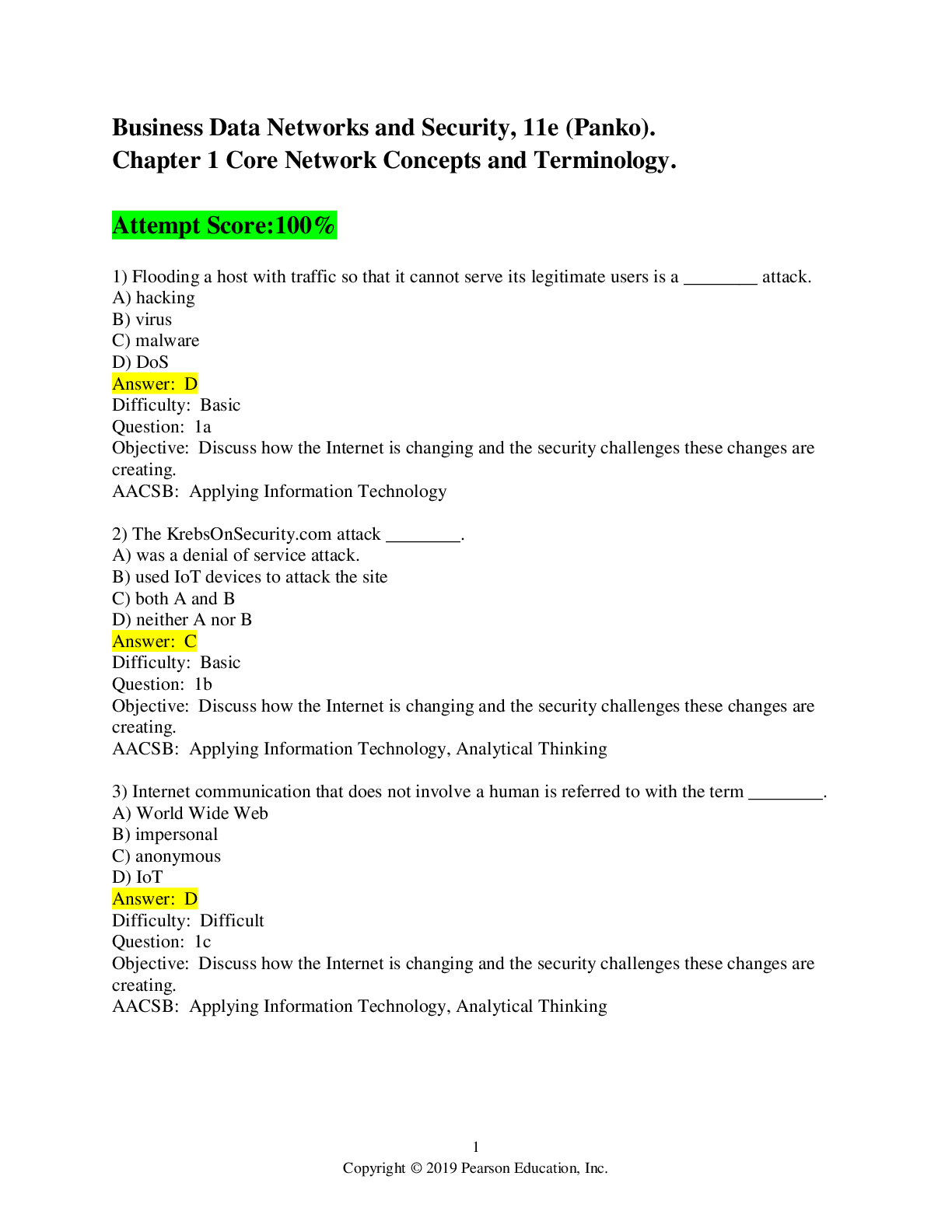
Reviews( 0 )
Recommended For You
Computer Networking> EXAM > Chapter 5 Ethernet (802.3) Switched LANs >Business Data Networks and Security, 11e (Panko) > 2023 > Score A+ (All)
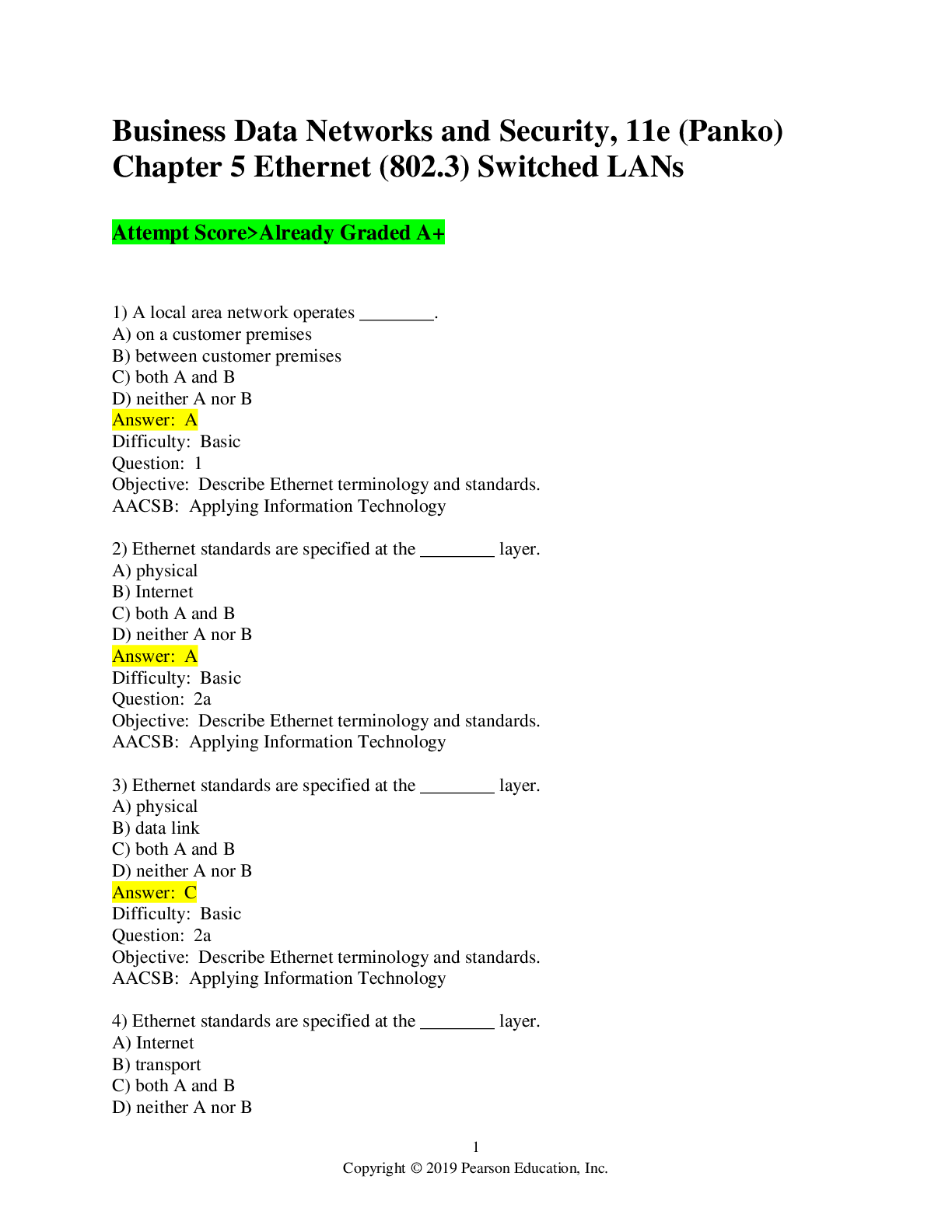
Chapter 5 Ethernet (802.3) Switched LANs >Business Data Networks and Security, 11e (Panko) > 2023 > Score A+
1) A local area network operates ________. A) on a customer premises B) between customer premises C) both A and B D) neither A nor B Difficulty: Basic Question: 1 Objective: Describe Ether net termino...
By Expert#1 , Uploaded: Sep 19, 2019
$7
Computer Networking> EXAM > Chapter 8 TCP/IP Internetworking I > Business Data Networks and Security, 11e (Panko) > Latest Exam > Score A+ (All)
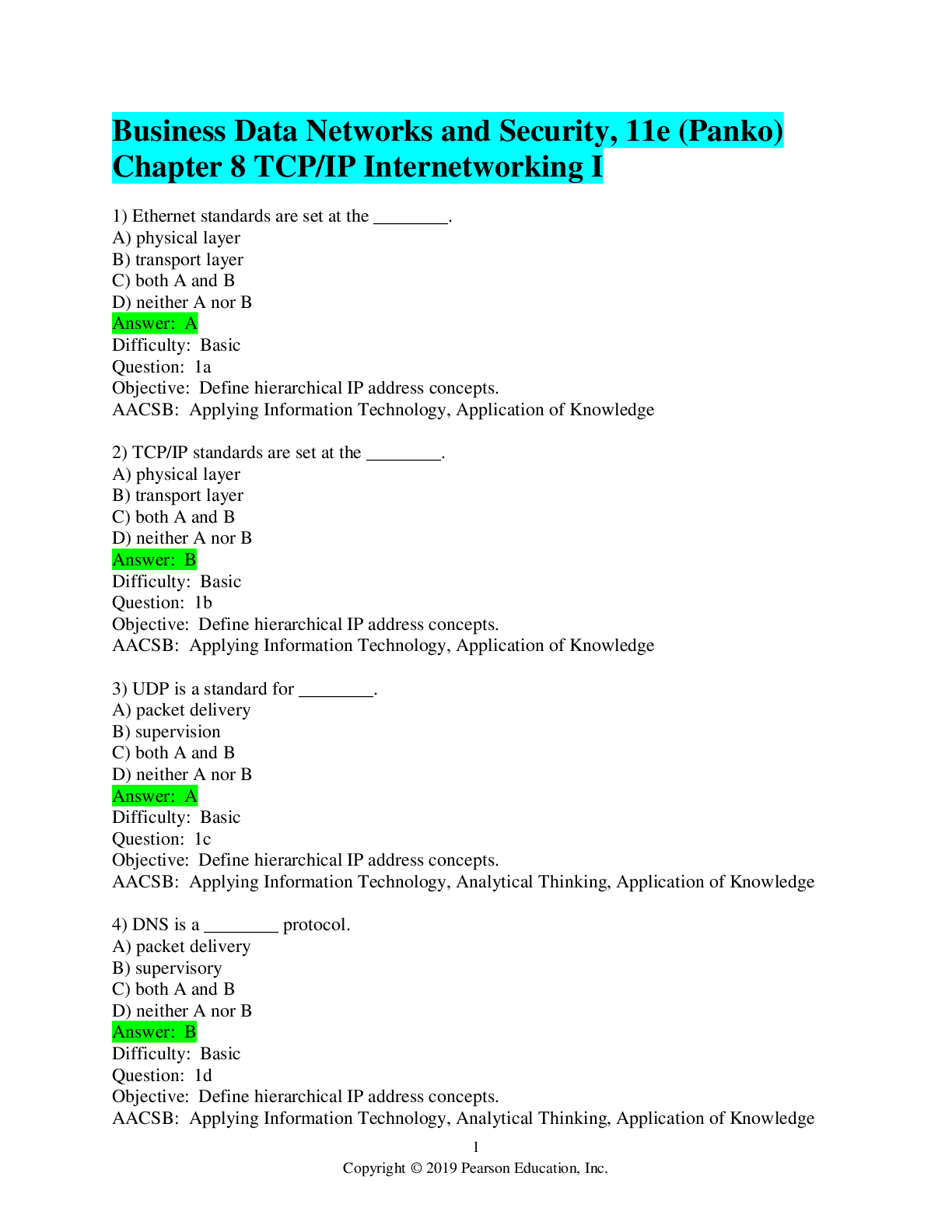
Chapter 8 TCP/IP Internetworking I > Business Data Networks and Security, 11e (Panko) > Latest Exam > Score A+
1) Ethernet standards are set at the ________. A) physical layer B) transport layer C) both A and B D) neither A nor B Difficulty: Basic Question: 1a Objective: Define hierarchical IP address concepts...
By Expert#1 , Uploaded: Sep 19, 2019
$8.5
Business Management> EXAM > Business Data Networks and Security, 11e (Panko) Appendix: Managing the Security Process>Attempt Score-All the Answers Correct {100% (All)
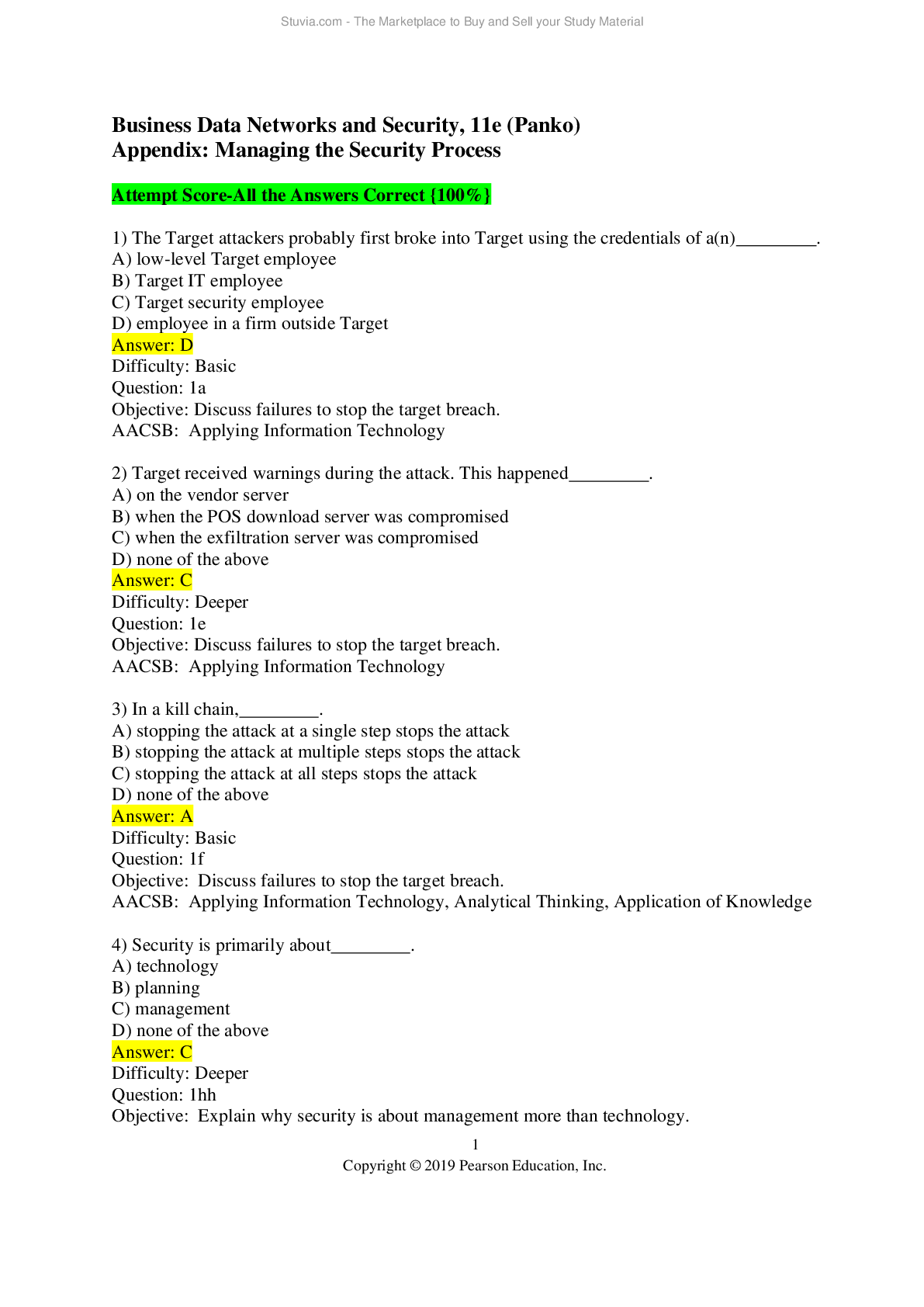
Business Data Networks and Security, 11e (Panko) Appendix: Managing the Security Process>Attempt Score-All the Answers Correct {100%
Business Data Networks and Security, 11e (Panko) Appendix: Managing the Security Process>Attempt Score-All the Answers Correct {100%
By QUIZ BIT , Uploaded: Jun 03, 2021
$10
Computer Networking> EXAM > Business Data Networks and Security, 11e (Panko) Chapter 4 Network Security (2019 Latest) Already Graded {A+} (All)
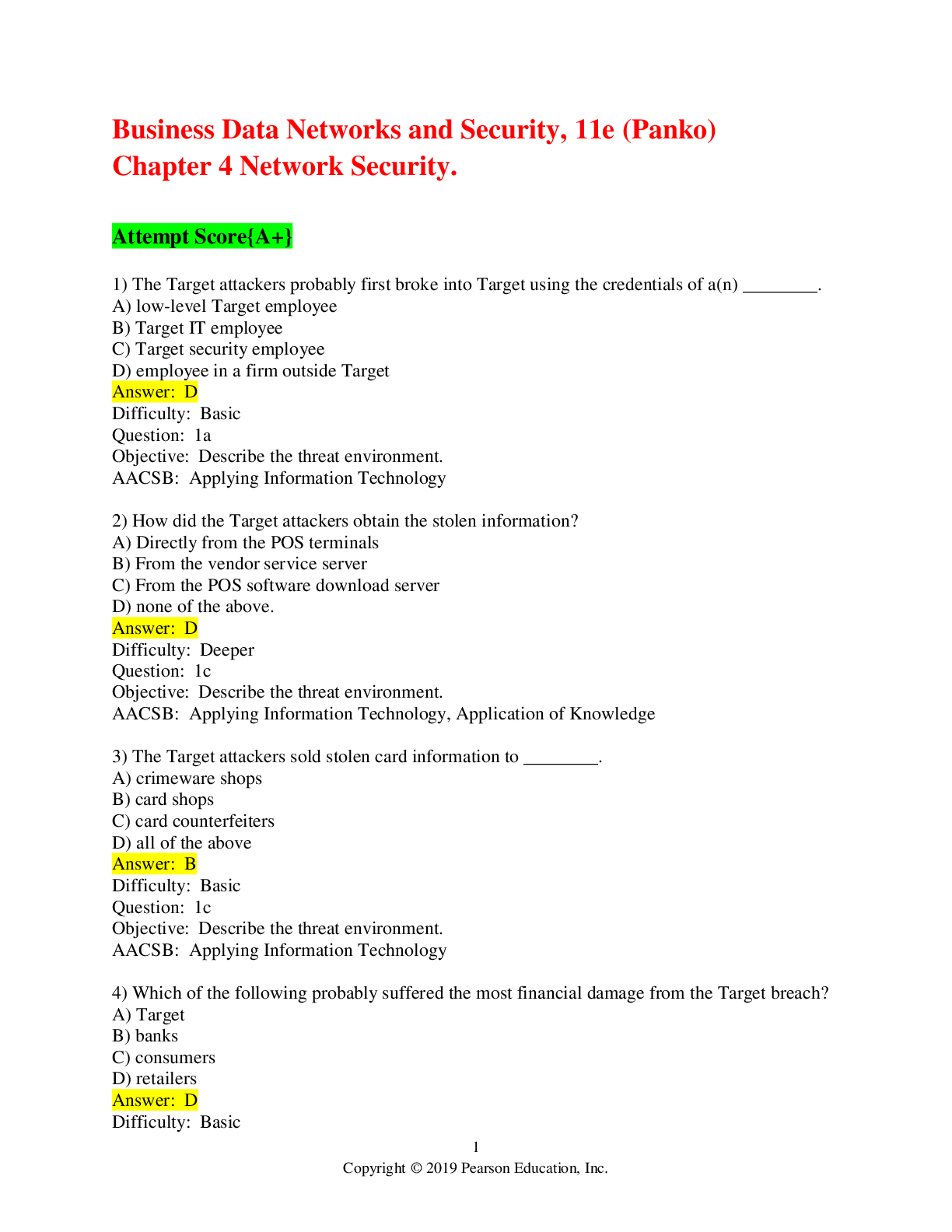
Business Data Networks and Security, 11e (Panko) Chapter 4 Network Security (2019 Latest) Already Graded {A+}
1) The Target attackers probably first broke into Target using the credentials of a(n) ________. A) low-level Target employee B) Target IT employee C) Target security employee D) employee in a fir...
By Expert#1 , Uploaded: Sep 19, 2019
$12
Computer Networking> EXAM > Chapter 6 Wireless LANS I > Business Data Networks and Security, 11e (Panko) > 2019 Latest Exam > Already Graded A (All)
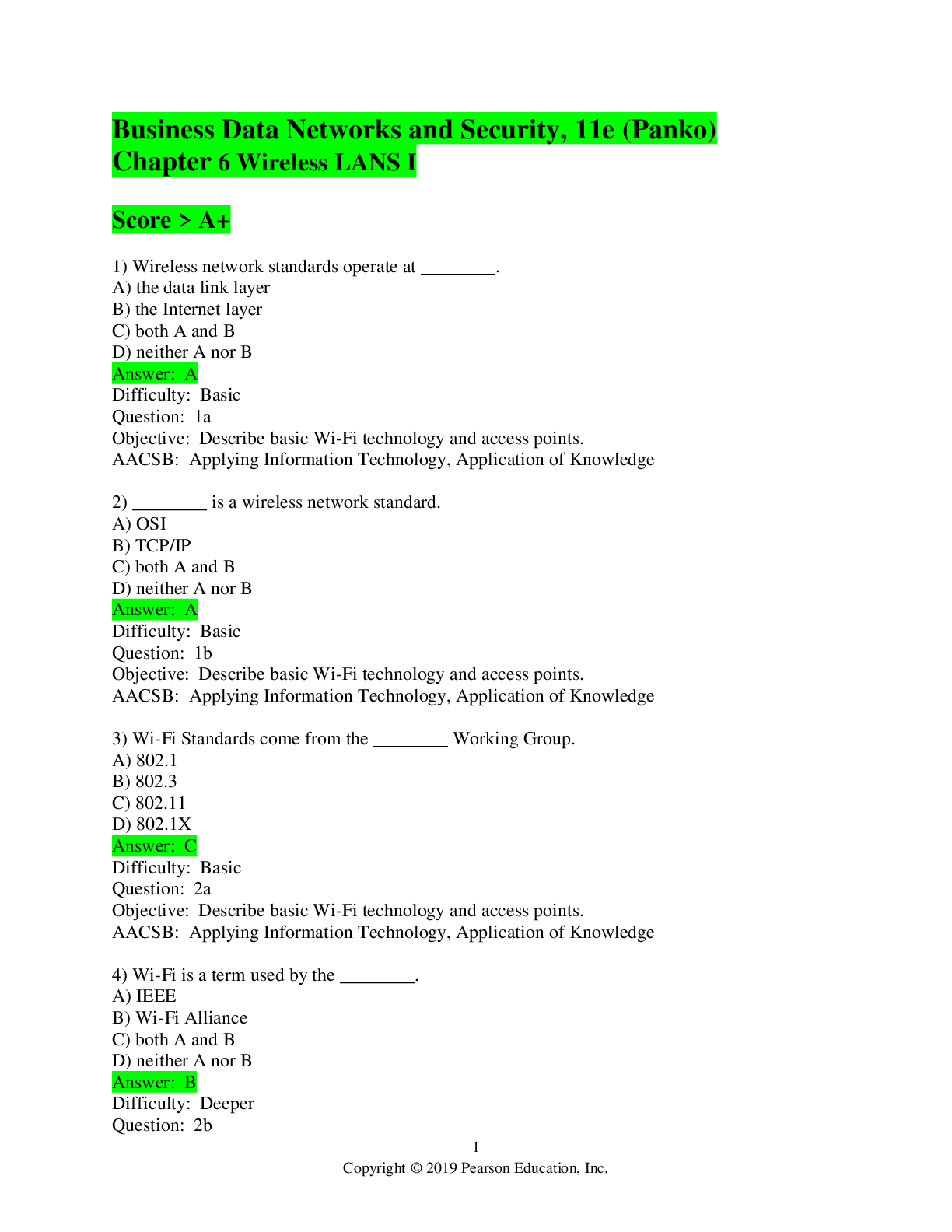
Chapter 6 Wireless LANS I > Business Data Networks and Security, 11e (Panko) > 2019 Latest Exam > Already Graded A
1) Wireless network standards operate at ________. A) the data link layer B) the Internet layer C) both A and B D) neither A nor B Difficulty: Basic Question: 1a Objective: Describe basic Wi...
By Expert#1 , Uploaded: Sep 19, 2019
$10
Computer Networking> EXAM > Chapter 7 Wireless LANS II > Business Data Networks and Security, 11e (Panko) > Clean {A} Latest Exam. (All)
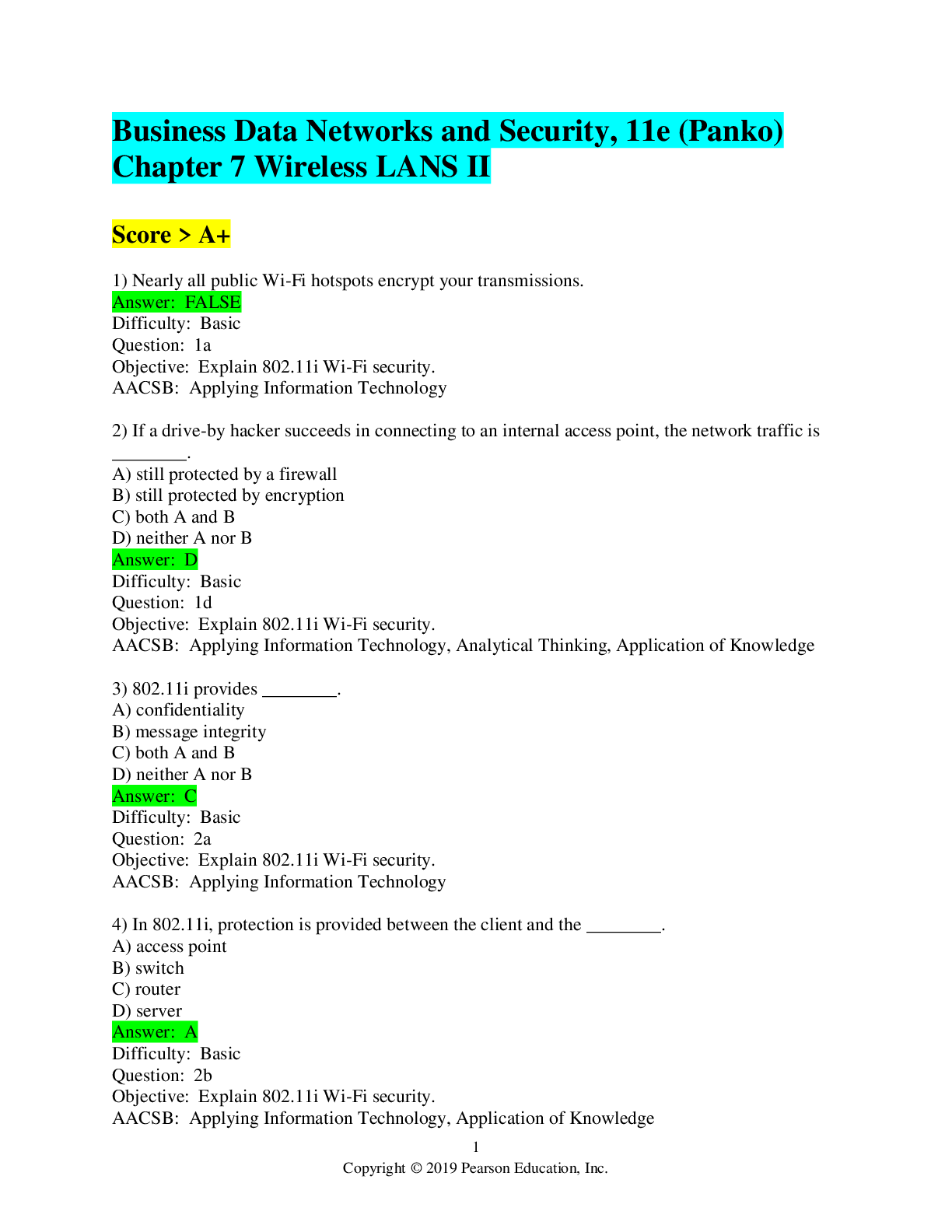
Chapter 7 Wireless LANS II > Business Data Networks and Security, 11e (Panko) > Clean {A} Latest Exam.
Business Data Networks and Security, 11e (Panko) Chapter 7 Wireless LANS II 1) Nearly all public Wi-Fi hotspots encrypt your transmissions. Answer: FALSE Difficulty: Basic Question: 1a Objective: Expl...
By Expert#1 , Uploaded: Sep 19, 2019
$13.5
Computer Networking> EXAM > Business Data Networks and Security, 11e (Panko) Chapter 2 Network Standards>Attempt score-100% correct (All)

Business Data Networks and Security, 11e (Panko) Chapter 2 Network Standards>Attempt score-100% correct
Business Data Networks and Security, 11e (Panko) Chapter 2 Network Standards 1) Internet standards are published as ________. A) RFCs B) IETFs C) TCP/IPs D) Internet Protocols Difficulty: Ba...
By Expert#1 , Uploaded: Sep 18, 2019
$10
Computer Networking> EXAM > Business Data Networks and Security, 11e (Panko)-Appendix: Managing the Security Process-Graded A+ (All)
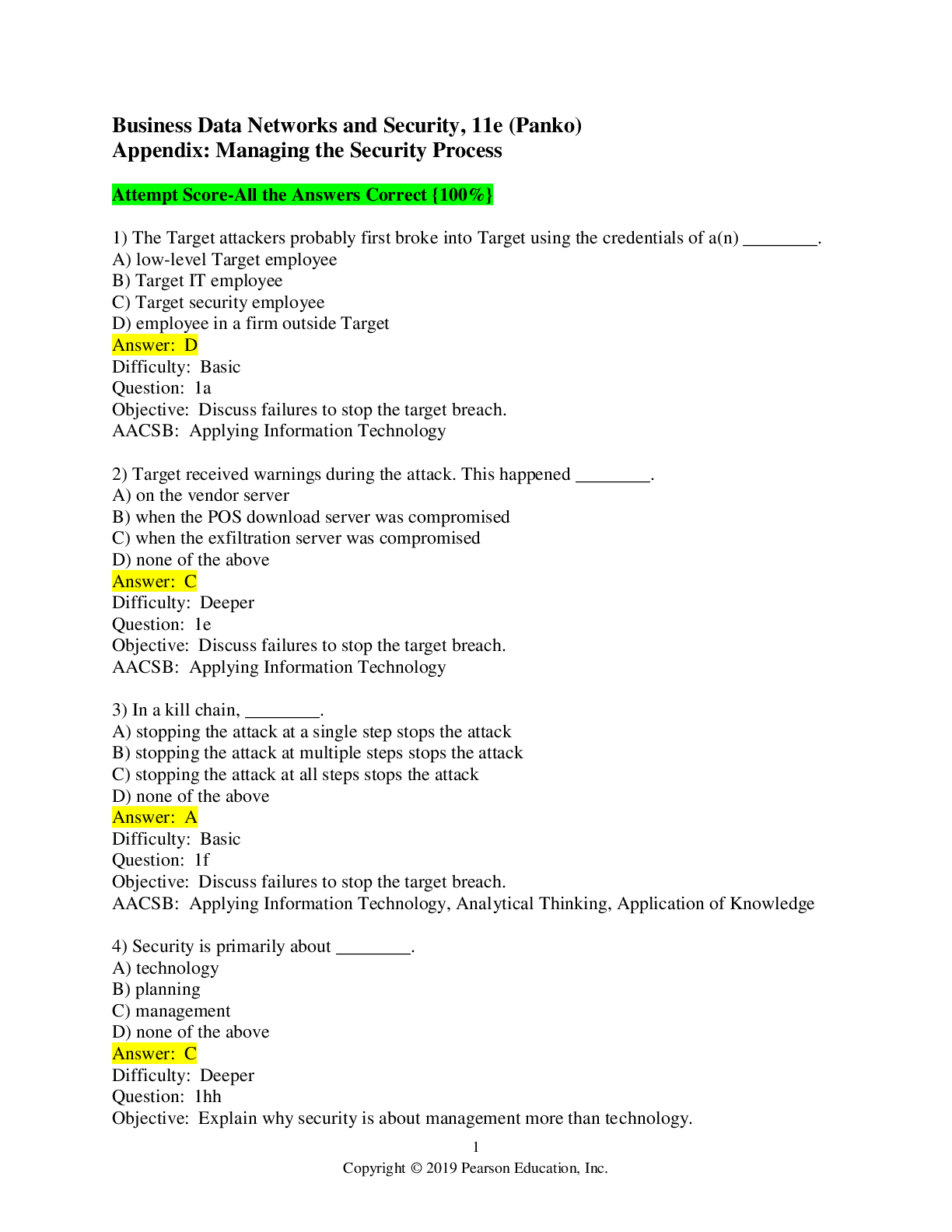
Business Data Networks and Security, 11e (Panko)-Appendix: Managing the Security Process-Graded A+
Business Data Networks and Security, 11e (Panko) Appendix: Managing the Security Process 1) The Target attackers probably first broke into Target using the credentials of a(n) ________. A) low-le...
By Expert#1 , Uploaded: Sep 19, 2019
$9.5
Computer Networking> EXAM > Chapter 3 Network Management > Business Data Networks and Security, 11e (Panko)>Latest 2019>Already Graded A+ (All)
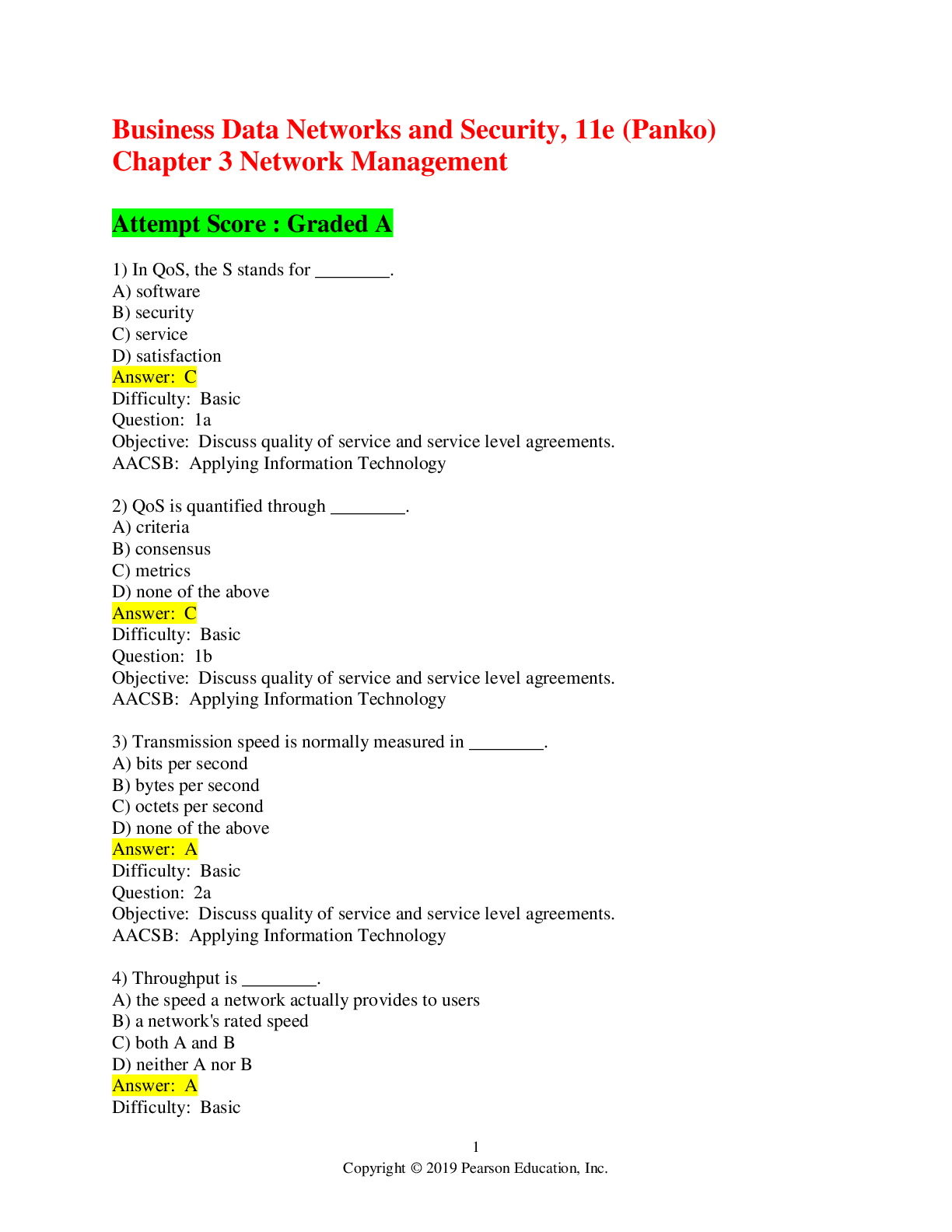
Chapter 3 Network Management > Business Data Networks and Security, 11e (Panko)>Latest 2019>Already Graded A+
1) In QoS, the S stands for ________. A) software B) security C) service D) satisfaction Difficulty: Basic Question: 1a Objective: Discuss quality of service and service level agreements. A...
By Expert#1 , Uploaded: Sep 19, 2019
$7.5
Business> EXAM > Business Data Networks and Security, 11e (Panko) Chapter 5 Ethernet (802.3) Switched LANs-with verified answers-2022-2023 (All)
 Chapter 5 Ethernet (802.png)
Business Data Networks and Security, 11e (Panko) Chapter 5 Ethernet (802.3) Switched LANs-with verified answers-2022-2023
Business Data Networks and Security, 11e (Panko) Chapter 5 Ethernet (802.3) Switched LANs-with verified answers-2022-2023 1) A local area network operates . A) on a customer premises B) between c...
By Studyrepository , Uploaded: Nov 02, 2022
$8
Document information
Connected school, study & course
About the document
Uploaded On
Sep 19, 2019
Number of pages
19
Written in
Additional information
This document has been written for:
Uploaded
Sep 19, 2019
Downloads
0
Views
69






